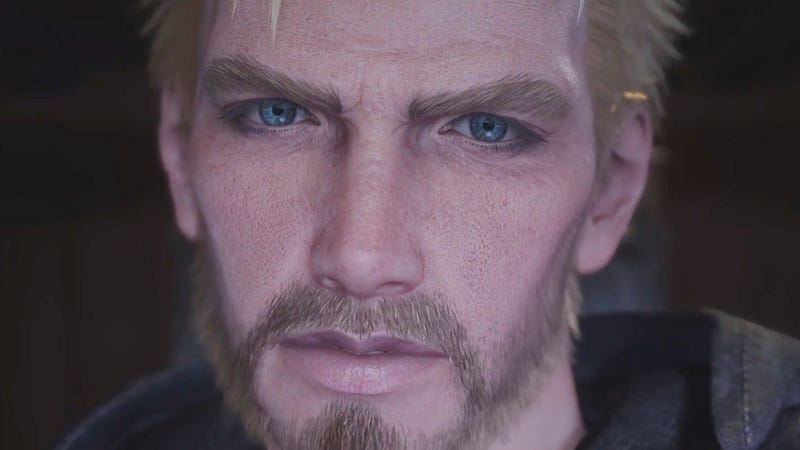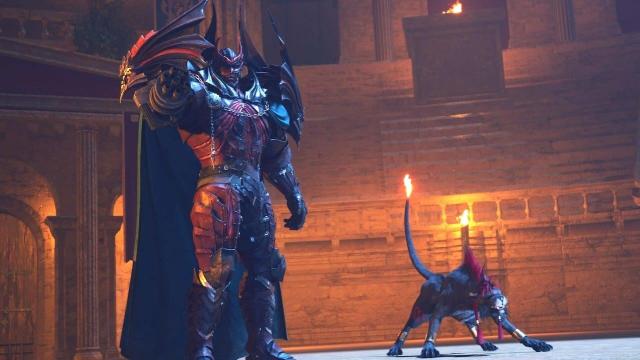In extending one 40-hour RPG into three separate, equally long, titles Square Enix has found a lot of ways to build out the world of Final Fantasy VII. Rebirth, the second entry in the trilogy, takes it a step further than its predecessor by packing the now-sprawling world full of activities. Extending the story has also allowed Square Enix to revisit and expand upon beloved characters from the larger Final Fantasy VII universe. But in its opulent reimaging of the original, Rebirth finds itself falling into one the remake trilogy’s most dangerous obsessions—becoming a nostalgia tour of what fans love, sometimes at the expense of narrative cohesion. No place is this more evident than in how Rebirth presents the interactive play Loveless.

The first time players are able to explore the Gold Saucer amusement park, they visit Event Square, home of the theater that puts on Loveless. In the entryway to the theater Cloud and his companion, see portraits of past and present actors from the show. One stands out: Jessie. While those who played the original and Remake will remember Jessie as the Avalanche demolitions expert who can’t stop flirting with Cloud, she previously worked as an actress at the Gold Saucer. In the wake of her death in Midgar, Cloud and his companion reflect on Jessie as a person in one of Rebirth’s many small but incredibly well-written character moments. (If you are with Tifa, she will talk about how much Jessie inspired her.)
After Remake fleshed out Jessie to great success, it’s an equally sombre moment for the player to reflect on the loss of a great character. But upon returning to the theatre during the Gold Saucer date, we learn Shinra has used state-of-the-art technology to recreate Jessie’s performance in virtual reality. For enjoyment of fans, Shinra will make Jessie live on in a pale imitation, as corporate property. On one level this sickening act on Shinra works within the narrative of Rebirth, another example of Shinra’s callous disregard for life – be it of the planet or people. But in the spirit of the remake trilogy’s metatextual themes, the return of Jessie feels off. In its most indulgent moments Square Enix takes the same path as Shinra in its approach to characters in the world of FF7 — if fans like it, why not bring it back?

This is the case with Jessie. While the emotional recollection Cloud shares after encountering her portrait helps bring the surviving characters closer, her appearance in Loveless lacks any consequence to the story. Cloud, Barret, and Tifa eagerly watch the mute recreation of Jessie perform Loveless like Shinra’s doll. But beyond saying she really was a star, they don’t comment upon the disgusting use of their dead friend’s likeness or in any way protest. Jessie’s appearance in all her splendor feels all for the benefit of the player’s enjoyment, but our main characters should find it ghoulish.
These kind of “memberberries” can be seen through Remake and Rebirth, in how the two games sometimes play out like a who’s who of The Compilation of Final Fantasy VII. Characters like Glenn Lodbrok or Cissnei, both of whom come from FF7’s many spinoffs, feel stitched into the larger narrative in hopes of satisfying those dozens of people who will go “Hey, I love that obscure spinoff character!” And while this is done more gracefully in some places, such as Cissnei’s appearance in Gongaga, Glenn Lodbrok’s secret meetings with Rufus are more baffling. This desire to bring everything from the complicated tendrils of the extended FF7 universe together into a cohesive way leads to a lot of bloat.

Maybe fans want this? After all, the remake trilogy feels geared towards those who have poured over every bit of extended lore, and at the end of the day the first goal of any remake is to satisfy the expectations of players. But too often, these nostalgia plays derail the story and even take away from its narrative weight. Remake got away with its extension of the short Midgar section from the original because it was often deft at weaving its many threads together, and was helped along by the game’s metanarrative on the challenges of a remake.
There are still moments where the remake trilogy masterfully handles this delicate balance. One of Rebirth’s best side quests, Cosmo Canyon’s Protrelic quest, expands heavily on Jessie and the rest of the lost Avalanche crew through the lens of how Barret and Tifa deal with grief and survivor’s guilt. It is meaningful, well-written, and the optional nature of it keeps it from muddying the main story too much. But these meaningful uses of the remake trilogy’s extended runtime feel few and far between, too often twisting Rebirth into a Final Fantasy VII amusement park and not a worthwhile narrative in its own right.

Leave a Reply